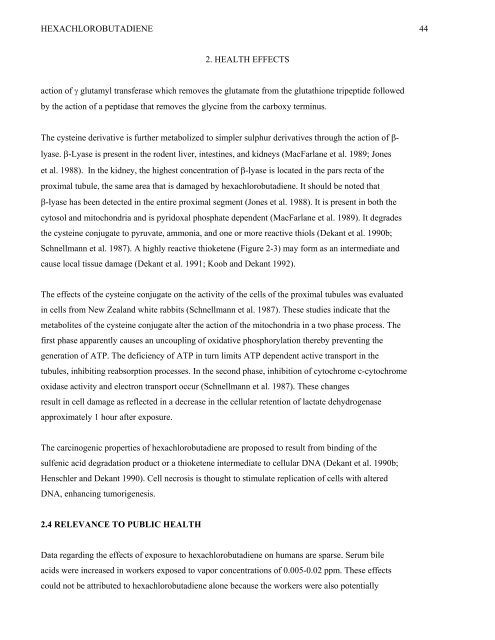hexachlorobutadiene - Davidborowski.com
hexachlorobutadiene - Davidborowski.com
hexachlorobutadiene - Davidborowski.com
You also want an ePaper? Increase the reach of your titles
YUMPU automatically turns print PDFs into web optimized ePapers that Google loves.
HEXACHLOROBUTADIENE 44<br />
2. HEALTH EFFECTS<br />
action of γ glutamyl transferase which removes the glutamate from the glutathione tripeptide followed<br />
by the action of a peptidase that removes the glycine from the carboxy terminus.<br />
The cysteine derivative is further metabolized to simpler sulphur derivatives through the action of β-<br />
lyase. β-Lyase is present in the rodent liver, intestines, and kidneys (MacFarlane et al. 1989; Jones<br />
et al. 1988). In the kidney, the highest concentration of β-lyase is located in the pars recta of the<br />
proximal tubule, the same area that is damaged by <strong>hexachlorobutadiene</strong>. It should be noted that<br />
β-lyase has been detected in the entire proximal segment (Jones et al. 1988). It is present in both the<br />
cytosol and mitochondria and is pyridoxal phosphate dependent (MacFarlane et al. 1989). It degrades<br />
the cysteine conjugate to pyruvate, ammonia, and one or more reactive thiols (Dekant et al. 1990b;<br />
Schnellmann et al. 1987). A highly reactive thioketene (Figure 2-3) may form as an intermediate and<br />
cause local tissue damage (Dekant et al. 1991; Koob and Dekant 1992).<br />
The effects of the cysteine conjugate on the activity of the cells of the proximal tubules was evaluated<br />
in cells from New Zealand white rabbits (Schnellmann et al. 1987). These studies indicate that the<br />
metabolites of the cysteine conjugate alter the action of the mitochondria in a two phase process. The<br />
first phase apparently causes an uncoupling of oxidative phosphorylation thereby preventing the<br />
generation of ATP. The deficiency of ATP in turn limits ATP dependent active transport in the<br />
tubules, inhibiting reabsorption processes. In the second phase, inhibition of cytochrome c-cytochrome<br />
oxidase activity and electron transport occur (Schnellmann et al. 1987). These changes<br />
result in cell damage as reflected in a decrease in the cellular retention of lactate dehydrogenase<br />
approximately 1 hour after exposure.<br />
The carcinogenic properties of <strong>hexachlorobutadiene</strong> are proposed to result from binding of the<br />
sulfenic acid degradation product or a thioketene intermediate to cellular DNA (Dekant et al. 1990b;<br />
Henschler and Dekant 1990). Cell necrosis is thought to stimulate replication of cells with altered<br />
DNA, enhancing tumorigenesis.<br />
2.4 RELEVANCE TO PUBLIC HEALTH<br />
Data regarding the effects of exposure to <strong>hexachlorobutadiene</strong> on humans are sparse. Serum bile<br />
acids were increased in workers exposed to vapor concentrations of 0.005-0.02 ppm. These effects<br />
could not be attributed to <strong>hexachlorobutadiene</strong> alone because the workers were also potentially

















